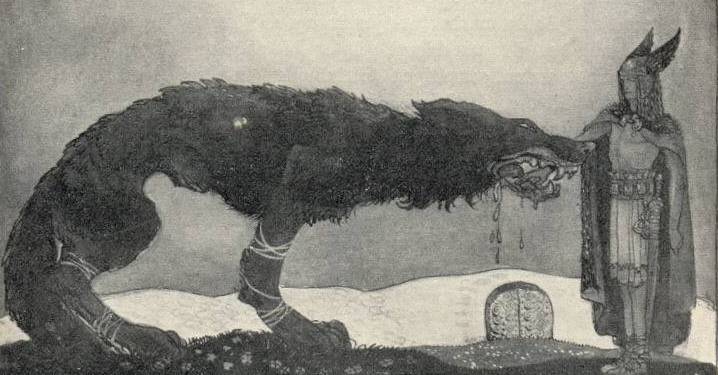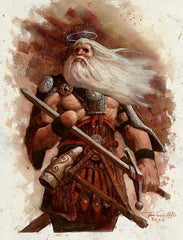on all orders over $100
on all orders over $100

Tyr was primarily known as the god of war in Norse Mythology and was renowned for his bravery, however he was also associated with justice and law. Although there were relatively few references to him in the Norse Sagas some modern historians believe that he may once have played a key role amongst the Norse Gods.
The name 'Tyr' shares a common origin with the 'Tiwaz' rune, ᛏ, which was a letter of the runic alphabet equivalent to 't' in modern English. It is also believed to have influenced the word for 'Tuesday' which stems from the phrase 'Tyr's Day' in many germanic languages, including English.
During the Roman occupation of Northern Europe there were various writings from Roman historians about the religion of the Germanic peoples prior to the start of the Viking age. The writings of Tacitus stated that there were three main gods which the northmen made animal sacrifices; Mercury, Hercules and Mars.
It is generally understood that these gods were the Roman equivalents of the gods that the norsemen knew as Odin, Thor and Tyr respectively. In this time period Tyr was known by his earlier name 'Tiwaz' and like Mars was the god of war, which is why the Roman texts refer to him by this name.
The fact that these three were the only ones mentioned by Tacitus indicates the importance of Tyr's role within the religion of the Norsemen. It is thought that initially he was one of the central gods, perhaps even the leader of the Norse pantheon, even his importance did decline towards the end of the Viking age.
There were similar one handed gods depicted in artwork throughout Northern Europe for centuries and perhaps even millennia prior to the Viking Age suggesting that Tyr and his equivalent Gods were very old and well established in the region. One example was the one handed God Naudu in Celtic mythology from Ireland.

Tyr compared to Mars in an 18th century manuscript
There are several references in the old Viking poems, including from the Poetic Edda that confirm that Tyr was one of the gods of war, along with Odin and Thor. This was also confirmed by the Roman sources when they compared him the their own god of war, Mars.
Aside from his role as a warrior there was also some evidence of Tyr's role as an enforcer of the law and upholder of justice. There was one saga in the Poetic Eddas, known as the Lokasenna, where the Gods are having a feast and Loki taunted Tyr by stating that 'it will be difficult for him to be the right hand of justice' since Tyr only had one hand. This gives us some insight into his role in society, due to the context Loki was setting in his joke that implies that Tyr's role in society.
Tyr was also well known for being 'the bravest of all of the Gods' which can be seen by his willingness to self sacrifice in 'the binding of Fenrir' when he stepped up when none of the other Norse Gods would dare to.
It is theorised by many Norse scholars that Tyr, along with many others, may have been a son of Odin. In the Prose Edda Snorri Sturluson described him as being the 'God of battles and son of Odin'.
Another theory was that Tyr was the son of Hymir, who was a frost giant that featured in various sagas including Thor's fishing trip encounter with Jormungandr. This was mentioned in the first part of the Prose Edda known as 'Gylfaginning'.
It is not known which of these two accounts is to be believed, since both of them were written by the same author which is somewhat confusing and contradictory.

Tyr (CC BY SA)
One of the only surviving sagas in which Tyr is a prominent character is 'the binding of Fenrir'. In this story the wolf Fenrir was growing rapidly, and fearing that they would soon lose their ability him the Gods decided to bind him to prevent him from fulfilling the destruction he would cause during Ragnarok.
They tried to trick the wolf by challenging him to prove his strength and break free from their chain, however the chain had magical properties and had been forged by drawves to be extremely strong but also very light. Sensing a trap Fenrir only agreed to let them tie him if one of the Gods would also agree to put their hand into his mouth while they did so. The only God willing and brave enough to make the sacrifice was Tyr, who put his arm into Fenrir's mouth. Once the wolf realised he had been tricked and the chain was unbreakable he bit down on Tyr's arm, ripped it off and swallowed it whole.
The giant wolf was then tied to a giant boulder and left there in chains, until he would eventually break free during Ragnarok. Unfortunately Tyr's sacrifice would be in vain and the prophecy would be fulfilled inevitably, with many of the Aesir dying in the battle that ensued. In this great battle Tyr and another wolf named Garm, who is quite possibly Fenrir going by another name, would fight each other to the death.
As with many of the Norse Gods, Tyr was also destined to be slain at the battle of Ragnarök. In the Poetic Edda one verse states that a giant wolf name 'Garm' would howl loudly to signal the beginning of Ragnarok and wreak havoc upon the world. This fearsome creature was said to be the guardian of the underworld ruled over by the goddess Hel, and was also destined to slay Tyr during the battle.
It is unknown whether Garm and Fenrir were actually the same creature by different names, as is often speculated about many of the characters in Norse Mythology. It is possible that, due to their history in 'the binding of Fenrir', it was the same wolf that Tyr would be fighting in the final battle. Regardless of whether or not Gnar and Fenrir were one and the same, it is clear that the prophecy predicted Tyr to fight a giant wolf to the death, being killed but also inflicting mortal wounds upon his enemy during the process.
If you enjoyed our article or have anything to add then please leave a comment below.
Check out some of our other handmade Viking Axes.
1. https://norse-mythology.org/gods-and-creatures/the-aesir-gods-and-goddesses/tyr/
2. https://thenorsegods.com/tyr/
3. History of the Danes, Saxo Grammaticus
4. https://www.worldhistory.org/Tyr/
5. Poetic Edda
6. https://en.wikipedia.org/wiki/Týr
Leave a comment